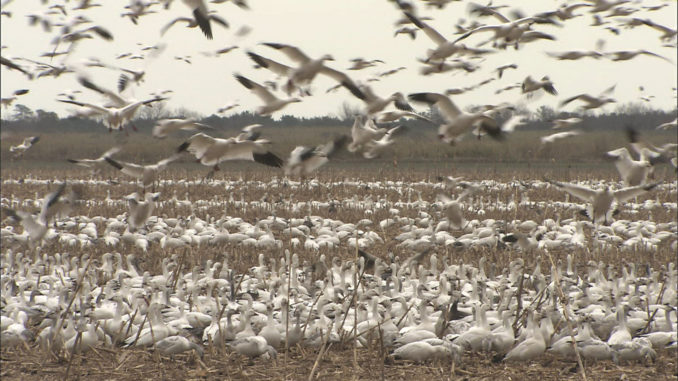
The U.S. Navy’s latest version of an environmental impact statement — in advance of plans to build an outlying landing field in Washington and Beaufort counties — isn’t much different from the last edition, except the service branch now admits the OLF at “Site C” will have “adverse effects” on area waterfowl.
The Draft Supplemental Environmental Impact Statement notes waterfowl inhabiting land near the OLF “may incur unavoidable adverse environmental effects.”
That means the Navy plans to drive away the birds or buy up as much land as it can — the plan calls for 50 square miles or 30,000 acres — and stop the planting of grains and other foodstuffs that attract the birds from Pungo Lake at Pocosin Lakes National Wildlife Refuge and Phelps lakes into airspace that would be shared by Navy F/A-18 Super Hornet carrier jet aircrafts.
As many as 200,000 waterfowl — tundra swans, snow geese and many varieties of ducks — winter at the refuge and nearby Phelps Lake and Lake Mattamuskeet for five months each year after migrating from Canada and Alaska. Each morning some 70,000 snow geese, weighing up to 10 pounds, and tundra swans, weighing as much as 20 pounds, fly in all directions from the lakes to farm fields to feed on winter wheat and oats.
If those bird flights continue, they would constitute a clear and present danger to Navy jets.
The SEIS also notes “homes, churches, and businesses may need to be relocated, depending on the land acquisition strategy,”
At least 74 farm families, many of whose families cleared the land during the Revolutionary War days, would be forced off their ancestral homes. Washington County, the fifth-poorest in North Carolina, could expect to lose $150,000 of its tax base.
But the OLF would allow Virginia Beach and Chesapeake, Va., residents to avoid the noise of the jets that would practice 31,000 takeoffs and landings, seven days a week, night and day. That noise would be transferred to North Carolina in order to reduce conflicts between Virginia citizens and the Navy and allow more and bigger real estate sales.
Chris Canfield, executive director of N.C. Audubon, one of the parties suing the Navy along with Washington and Beaufort counties, said the Feb. 23 SEIS release was nothing new.
“The Navy’s court-ordered Draft Supplemental EIS makes clear once again the disregard some leaders in the service have for the citizens of North Carolina and the natural treasures of the nation,” he said.
“They could have applied the time, energy and tax dollars that went into this Draft SEIS toward a reasonable solution that allows for safe training of its pilots. Instead, the Navy team has once again demonstrated its misguided preference for placing a jet landing field within miles of the winter home of 100,000 large swans, geese and other waterbirds.
“This site simply won’t work, no matter how many pages of rationalization are produced.
“Of course, the Navy has already invested millions of dollars in the Washington and Beaufort counties site, and they have, in fact, announced it as the location of the landing field in their recent budget proposal. So it is little wonder the study appears to be yet another attempt to justify a pre-ordained outcome.”
Canfield pointed out the SEIS showed no (zero) snow geese at the Site C preferred OLF area. Yet U.S. Fish and Wildlife Service biologists noted a peak of 78,000 snow geese at the Pungo Unit during early December 2006, a record count.
The Navy called off practice overflights of the area because of two near collisions with snow geese last year, late in the season when most snow geese and tundra swans already had left the area.
The Navy contends it can handle problems with potential bird strikes. Dennis Luscz, former N.C. Wildlife Resources Commission waterfowl project leader, has called tundra swans “flying bowling balls.”
“It will be hard for the Navy to manage what they can’t seem to find,” Canfield said.
Public hearings regarding the Navy’s SEIS will be held at many eastern N.C. communities during March.
Information sessions will occur from 4:30-6:30 p.m., followed by formal public hearings from 7-10 p.m. Public hearings have been scheduled at the following dates and locations:
* March 19, 2007, Mattamuskeet Elementary School, 60 Juniper Bay Road, Swan Quarter.
* March 20, 2007, Bertie High School, 715 U.S. Highway 13 North, Windsor.
* March 21, 2007, Perquimans County High School, 305 Edenton Road, Hertford.
* March 22, 2007, Craven County Community College, Orringer Hall, 800 College Court, New Bern.
* April 3, 2007, Beaufort Community College, 5337 U.S. Highway 264 East, Washington.
* April 4, 2007, Vernon G. James Research and Extension Center, N.C. State University, 207 Research Station Road, Plymouth.




Be the first to comment